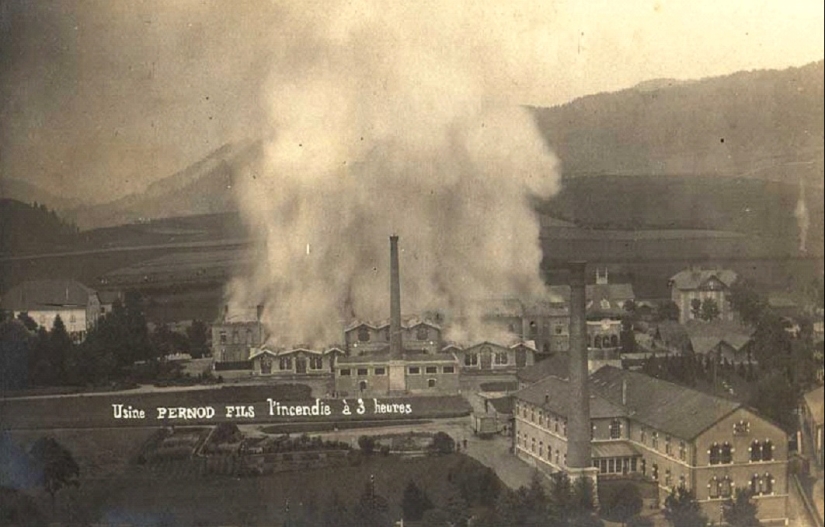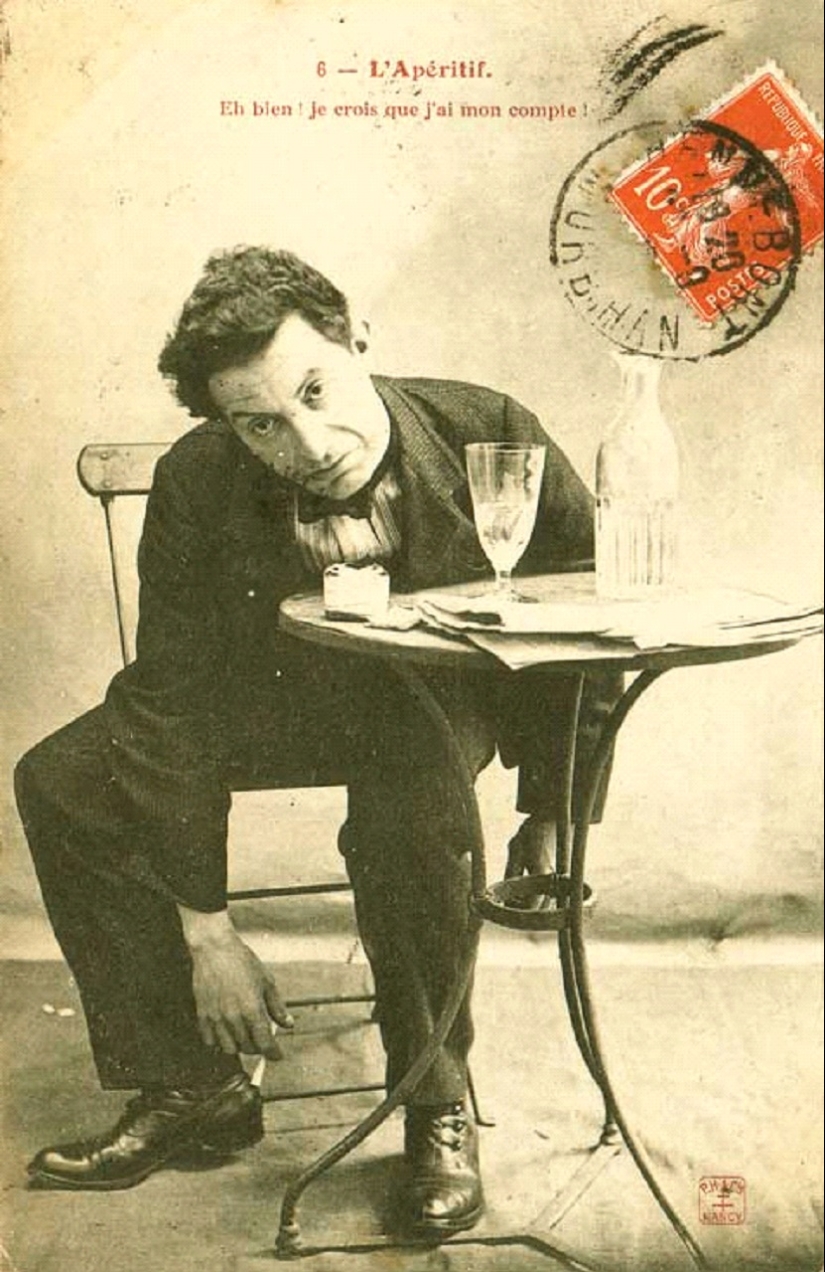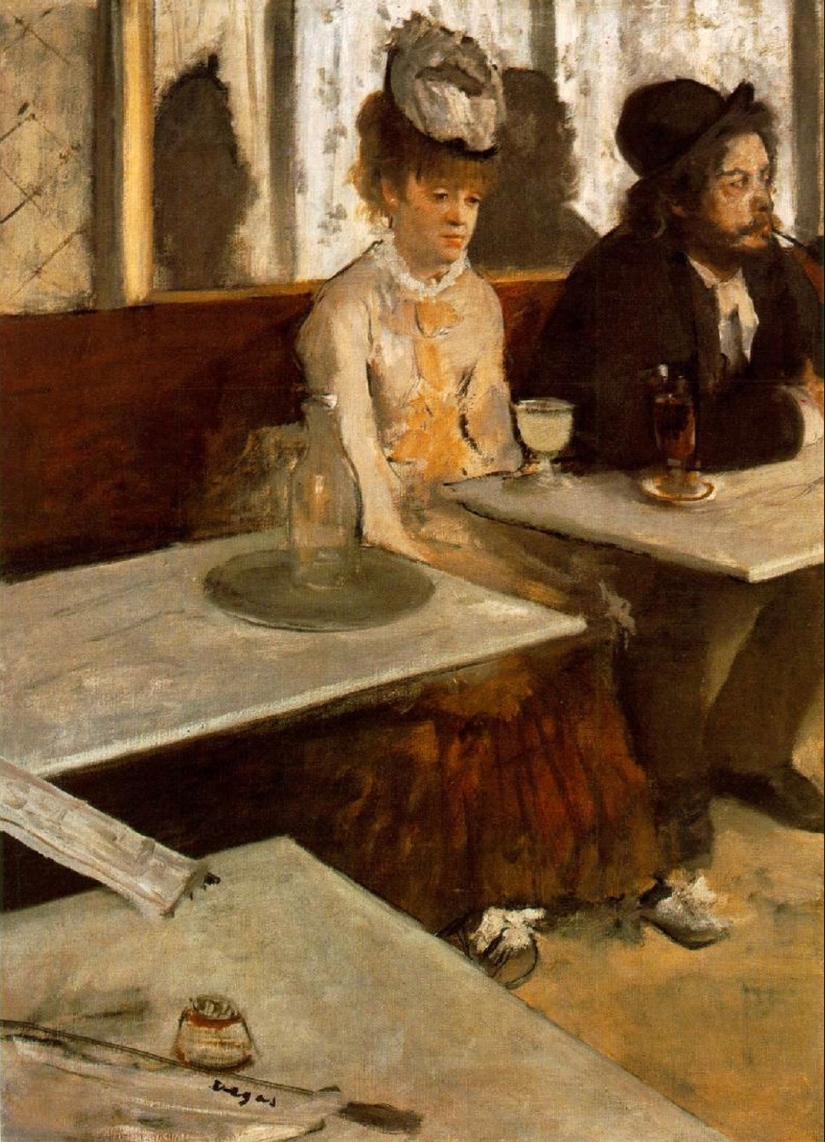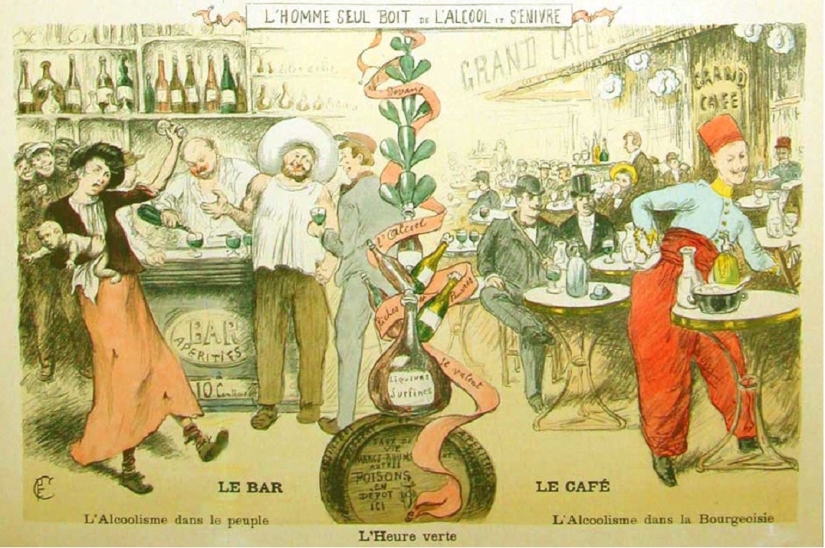Absinthe is a genius for mediocrity, but death is for a true genius
Categories: History
By Pictolic https://pictolic.com/article/absinthe-is-a-genius-for-mediocrity-but-death-is-for-a-true-genius1.htmlAbsinthe, undoubtedly, can be called a professional drink of intellectuals, artists and poets. In the XIX century, it was believed that absinthe was a genius for mediocrity, but death for a true genius. In the 80s of the XIX century, one word "absinthe" caused panic among many respectable Europeans, because this drink was strongly associated with insanity in their minds. In France, absinthe was called "madness in a bottle", and the phrase "Absinthe drives you crazy" became the most popular slogan of anti-alcohol campaigns. When and where did absinthe appear? Why was this drink banned in France and Switzerland? "Green Fairy" or "Green Witch"?


It is believed that absinthe appeared at the end of the XVIII century, and was invented by Dr. Pierre Ordiner, who lived in the Swiss village of Kuve. According to legend, here he found wild wormwood and created his own special drink, which quickly gained popularity in the district. Dr. Ordinaire died in 1821 — by this time the name "Green Fairy" and the fame of the tonic drink had already firmly established itself for absinthe. Other sources believe that the Enrio sisters, who lived in the same Swiss village, had already made absinthe before the arrival of Dr. Ordinaire and that it was they who sold the recipe for this drink to a certain Major Dubier.

Anyway, when Major Dubier tried absinthe, he found that this drink cures indigestion, improves appetite, helps with fever and chills. Dubier was so impressed that he bought a recipe and also began to produce absinthe. In 1797, the major's daughter married Henri-Louis Pernod, then the Pernod dynasty began, which gave the name to the absinthe brand of the same name.

The Pernod factory was a real example of efficiency and hygiene. By 1896, it was already producing 125,000 liters of absinthe a day! Everything went like clockwork until lightning struck the factory on August 11, 1901. There was so much alcohol on the premises that it took several days to extinguish the fire. Perhaps the fire would have been worse if one of the workers had not guessed to release huge tanks of absinthe into a nearby river. After that, its waters turned yellow-green, and the smell of alcoholic fumes emanating from it resembled the breath of a drunkard and could be heard for miles.

Drinking absinthe was one of the characteristic features of Parisian life during the reign of Napoleon III (1852-1870) — it was a respectable bourgeois custom. The time between five and seven o'clock in the evening was called the "green hour", and the smell of absinthe was carried in the air over the Parisian boulevards. It was believed that absinthe improves appetite before dinner, and the strict period of time allotted for drinking it protected people from abuse to some extent.

Given the strength of absinthe (the most respected brand "Pernod" contained 60% alcohol), it was customary to drink no more than one serving. You could drink absinthe before dinner or even before lunch, but if someone dared to drink it all night, it caused a contemptuous reaction from the waiters. The risk of absinthe abuse increased as people began to acquire a taste for the drink. More respectable absinthe lovers, who were ashamed to drink a lot in public, soon learned to move from one cafe to another.

Alcoholics quickly appreciated absinthe, and soon the drink began to attract a wider range of consumers: representatives of bohemia, women and the working class. In Emile Zola's novel The Trap, we find mention of a carpenter who "stripped naked on the Rue Saint-Martin and died dancing the polka. He was drinking absinthe."

Customs changed, now women could drink absinthe in cafes, and many of the absinthe women did not dilute the drink with water, which was explained by the reluctance to drink too much liquid, because they wear a corset. There are more and more posters showing emancipated women drinking absinthe and even smoking.

Paintings of the same period more often tell a completely different story — the story of emaciated women staring unseeingly into the void over a glass. Illustration: "Absentist", Felicien Rops.

A very strong attraction almost immediately arose between absinthe, as the most powerful intellectual drink, and Parisian bohemia. Absinthe occupies a special place in the history of French painting. Illustration: Edouard Manet, "The Bar at Folies Bergere".

It is sometimes said about the artist Henri de Toulouse-Lautrec that his paintings are entirely painted with absinthe. Much is known about the bitter drunkenness of Toulouse-Lautrec: His favorite cocktail was a concoction called Earthquake, a deadly combination of brandy and absinthe. "You need to drink little by little, but often," the artist said, and to maintain such a regime, he always took a cane with him, in which a half—liter supply of absinthe and a small glass were stored. Illustration: Henri de Toulouse-Lautrec, "At the Cafe La Mi".

"I assure you, madam, I can drink without risk. I'm already almost on the floor," Henri de Toulouse—Lautrec once said, hinting at his too small height (a little more than 150 cm). Unfortunately, heavy drinking and a life of starvation caused the artist a lot of harm, he began to get drunk from a very small dose, as is usually the case at the last stage of alcoholism. In addition to everything else, Toulouse-Lautrec became paranoid.

Toulouse-Lautrec saw terrible monsters, it even seemed to him that the elephant located in the courtyard of the Moulin Rouge began to follow him. And on March 1, 1899, one of the artist's friends received a letter with sad Paris news: "You will be sad to learn that Toulouse-Lautrec was put in an insane asylum yesterday." In the photo: an elephant located in the courtyard of the famous Parisian cabaret "Moulin Rouge" until 1906.

The story of what happened to Toulouse-Lautrec was told in different ways. Someone claimed that the artist had a persecution mania on the street, someone - that he was caught by orderlies and placed in a psychiatric hospital at the request of his mother. Anyway, after being discharged from the hospital, Toulouse-Lautrec started drinking again, at first with restraint, again resorting to the "absinthe cane", and then more and more. Illustration: Henri de Toulouse-Lautrec, "In the Moulin Rouge".

And in 1887, Henri de Toulouse-Lautrec painted a portrait of Vincent van Gogh with a glass of absinthe on the table in front of him. It is said that it was Toulouse-Lautrec who addicted Van Gogh to this drink.

In the same 1887, Vincent Van Gogh created a still life depicting a glass of absinthe and a carafe of water. The psychiatric experience that the artist had to go through repeatedly forced researchers of Van Gogh's work to enter the purely clinical sphere. Some commentators directly linked all the artist's illnesses to the fact that he abused absinthe.

In 1859, Eduard Manet painted his first major canvas, which he called "The Absinthe Lover". With this work, his career as an artist began very awkwardly. The model was his acquaintance, a junk dealer and alcoholic, who could often be found in the Louvre area. The artist saw in this man some strange dignity, even aristocracy. After finishing work on the painting, Manet showed it to his teacher, who reacted sharply negatively: "Absinthe lover! Why draw such abominations? My poor friend, you are the absinthe lover. It is you who have lost your morality." In the future, the picture continued to make an unpleasant impression on almost everyone who saw it.

The famous painting by Edgar Degas "Absinthe", first called "In a cafe" (1876), was received by the public even worse than Manet's canvas. "A person who values dignity and beauty will never call Absinthe a work of art," the critic wrote. Someone even suggested that this painting depicts the poet Paul Verlaine, who was known for leading a terrible life soaked through with absinthe.

Paul Verlaine became addicted to drinking very early, and the subsequent deaths of his father, beloved aunt and cousin only intensified his drunkenness: "I attacked absinthe," he wrote. After a while, Verlaine got married and seemed to come to his senses, but family happiness was soon destroyed by a catastrophe: Verlaine met the young poet Arthur Rimbaud and became obsessed with him, and when Rimbaud broke up with Verlaine, he shot him three times, wounding his former lover in the wrist. In the photo: Verlaine on the left, Rimbaud on the right.

Since then, Paul Verlaine has given up all hope of a decent life. He was even jailed for a month for threatening his mother with a knife, although his mother demanded that he be acquitted. After this incident, Verlaine finally plunged into the life of the cafe, becoming the main celebrity of the Latin Quarter, but his poetic reputation was so strong that even the police were ordered not to disturb Verlaine, no matter what he did.

In The Confessions, written in 1895, Verlaine repents of his dependence on absinthe: "Absinthe! How scary it is to think about those days and more recently... One sip of the disgusting witch (what a fool called her a fairy or a green muse!), one sip captivated me, but then my drunkenness led to more serious consequences." In the photo: Paul Verdun in the interior of a Paris cafe.

In August 1905, Swiss newspapers wrote about a terrible tragedy: thirty-year-old peasant Jean Lanfre, after drinking two glasses of absinthe, shot his pregnant wife in the head, and then killed his daughters (four-year-old Rose and two-year-old Blanche). Lanfre also tried to shoot himself, but survived. Staggering, he went out into the courtyard, where he fell asleep, clutching the dead body of his youngest daughter in his arms. The public reaction to this tragedy was unusually violent, and the outrage was not caused by the fact that Lanfre was an impenetrable drunkard who drank up to five liters of wine every day. People were sure that absinthe was to blame for what had happened. Illustration: "Absinthe is death."

A few weeks after the tragedy, residents of the surrounding towns and villages filed a petition in which 82,450 people demanded that absinthe be banned in Switzerland, which was done already in 1906. In France, absinthe was banned in 1915, when they thought about the national problems of alcoholism and the army's unpreparedness for the First World War. By the way, the last significant appearance of absinthe in art, just before its ban, was Pablo Picasso's Cubist sculpture "A Glass of Absinthe" (1914).

After the ban, absinthe remained for some time in Spain, Eastern Europe and Cuba. Ernest Hemingway wrote with the greatest nostalgia about the merits of this drink, who at that time lived in Florida and continued to drink absinthe after the French ban, receiving it from Cuba. In Hemingway's novel For Whom the Bell Tolls, one of the few consolations of his protagonist is absinthe, which brought back memories of the beautiful and carefree Parisian life that this American partisan was deprived of.

"One such mug replaced all the evening newspapers, all the evenings in Parisian cafes, all the chestnuts, which are probably already blooming... in short, everything that came back to him when he sipped this cloudy, bitter, tongue-chilling, warming the brain and stomach, changing the outlook on life of the witchcraft potion." And again: "There is nothing better than absinthe," Ernest Hemingway writes in the novel "For whom the Bell Tolls." Illustration: Jean Beraud, "In the cafe".

Absinthe was revived relatively recently — in 1990, when its production resumed in the Czech Republic and the drink was again launched on international markets under the Hill's brand.

The French and Swiss did not like the fact that at least some absinthe was revived somewhere: "This is disgusting foreign trash. If Baudelaire and Rimbaud had been offered this Czech swill, they would have turned over in their coffins."

One of the most ardent opponents of Czech absinthe in France was Marie-Claude Delae, the main French expert on absinthe, who in 1994 opened a museum of this drink in Auvers-sur-Oise, the place where Vincent Van Gogh is buried. In 2000, with the assistance of Marie—Claude Delae, a new brand of French-type absinthe was launched — La Fée ("Fairy").

Inspired by the stories of famous absintists, modern artists still create works dedicated to absinthe. Illustration: Elena Khotuleva, "Absinthe".

The revived "Green Fairy" again arouses thirst and excites the imagination, as if awakening the cultural memory of the mysterious, painful and so important drink of the decadent fin-de-siècle (late XIX — early XX century).

The material was prepared with the support of the Center for the Promotion and Development of Creativity of People Suffering from Mental Disorders, Daria Evseeva.
Recent articles

We offer you a selection of interesting facts from a variety of fields of knowledge. How does our body react to sneezing? Where did ...

Cold weather brings with it not only a wave of colds, but also skin problems. The body regularly suffers from a sharp change in ...

See what uninhibited ladies looked like at the height of the American baby boom. In those days, there was no trace of silicone, and ...